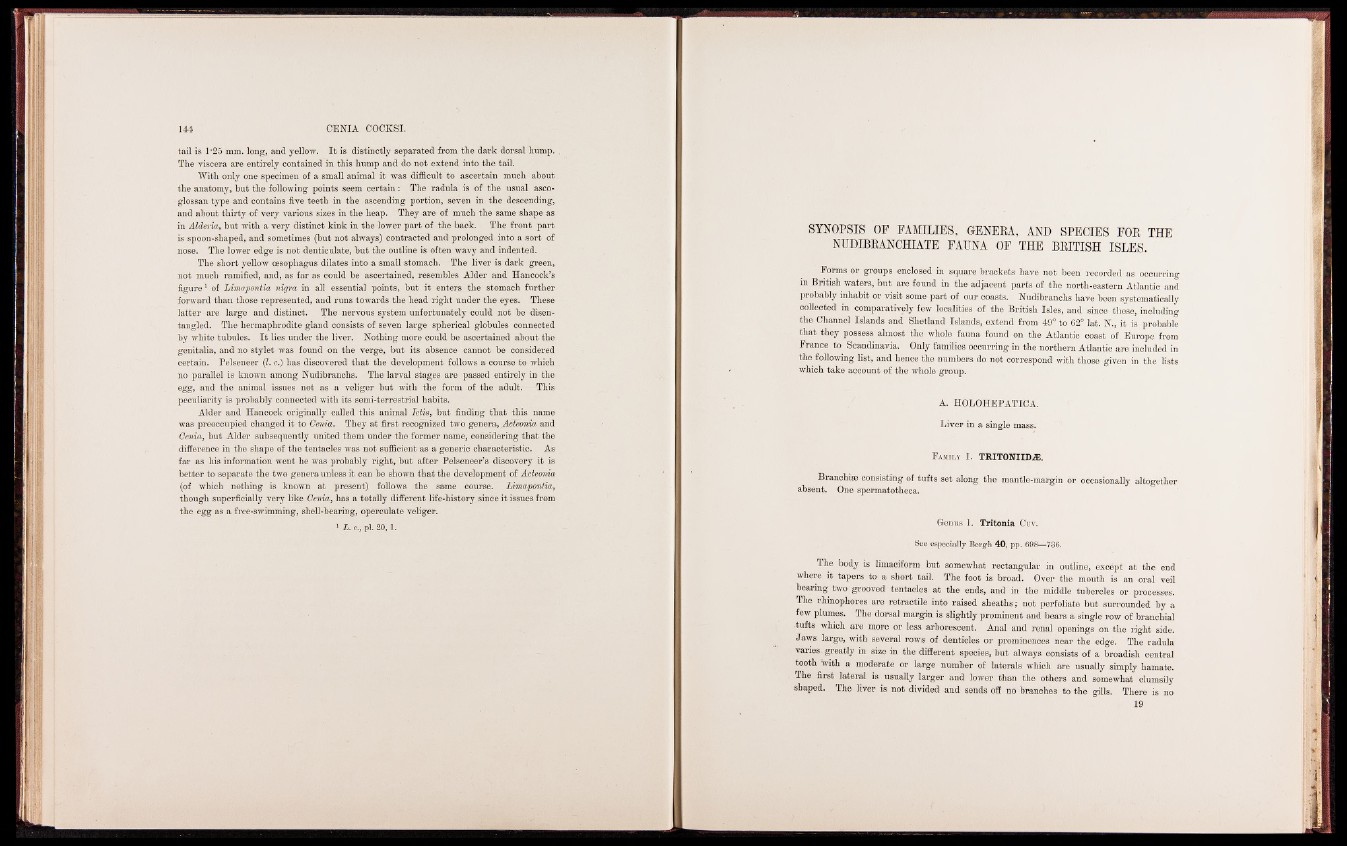
144 CENIA COCKSI.
tail is 1*25 mm. long, and yellow. It is distinctly separated from the dark dorsal hump.
The viscera are entirely contained in this hump and do not extend into the tail.
With only one specimen of a small animal it was difficult to ascertain much about
the anatomy, but the following points seem certain: The radula is of the usual ascoglossan
type and contains five teeth in the ascending portion, seven in the descending,
and about thirty of very various sizes in the heap. They are of much the same shape as
in Alderia, but with a very distinct kink in the lower part of the back. The front part
is spoon-shaped, and sometimes (but not always) contracted and prolonged into a sort of
nose. The lower edge is not denticulate, but the outline is often wavy and indented.
The short yellow oesophagus dilates into a small stomach. The liver is dark green,
not much ramified, and, as far as could be ascertained, resembles Alder and Hancock’s
figure1 of Limapontia nigra in all essential points, but it enters the stomach further
forward than those represented, and runs towards the head right under the eyes. These
latter are large and distinct. The nervous system unfortunately could not be disentangled.
The hermaphrodite gland consists of seven large spherical globules connected
by white tubules. It lies under the liver. Nothing more could be ascertained about the
genitalia, and no stylet was found on the verge, but its absence cannot be considered
certain. Pelseneer (l. c.) has discovered that the development follows a course to which
no parallel is known among Nudibranchs. The larval stages are passed entirely in the
egg, and the animal issues not as a veliger but with the form of the adult. This
peculiarity is probably connected with its semi-terrestrial habits.
Alder and Hancock originally called this animal Ictis, but finding that this name
was preoccupied changed it to Cenia. They at first recognized two genera, Acteonia and
Cenia, but Alder subsequently united them under the former name, considering that the
difference in the shape of the tentacles was not sufficient as a generic characteristic. As
far as his information went he was probably right, but after Pelseneer’s discovery it is
better to separate the two genera unless it can be shown that the development of Acteonia
(of which nothing is known at present) follows the same course. Limapontia,
though superficially very like Cenia, has a totally different life-history since it issues from
the egg as a free-swimming, shell-bearing, operculate veliger.
1 L. c., pi. 20,1.
SYNOPSIS OF FAMILIES, GENERA, AND SPECIES FOR THE
NUDIBRANCHIATE FAUNA OF THE BRITISH ISLES.
Forms or groups enclosed in square brackets have not been recorded as occurring
in British waters, but are found in the adjacent parts of the north-eastern Atlantic and
probably inhabit or visit some part of our coasts. Nudibranchs have been systematically
collected in comparatively few localities of the British Isles, and since these, including
the Channel Islands and Shetland Islands, extend from 49° to 62° lat. N., it is probable
that they possess almost the whole fauna found on the Atlantic coast of Europe from
France to Scandinavia. Only families occurring in the northern Atlantic are included in
the following list, and hence the numbers do not correspond with those given in the lists
which take account of the whole group.
A. HOLOHEPATICA.
Liver in a single mass.
Family I. TRITONIIDiE.
Branchiaa consisting of tufts set along the mantle-margin or occasionally altogether
absent. One spermatotheca.
Genus 1. Tritonia Guv.
- See especially Bergh 40, pp. 698—736.
The body is limaciform but somewhat rectangular in outline, except at the end
where it tapers to a short tail. The foot is broad. Over the mouth is an oral veil
bearing two grooved tentacles at the ends, and in the middle tubercles or - processes.
The rhinophores are retractile into raised sheaths; not perfoliate but surrounded by a
few plumes. The dorsal margin is slightly prominent and bears a single row of branchial
.tufts which are more or less arborescent. Anal and renal openings on the right side.
Jaws large, with several rows of denticles or prominences near the edge. The radula
varies greatly in size in the different species, but always consists of a broadish central
tooth with a moderate or large number of laterals which are usually simply hamate.
The first lateral is usually larger and lower than the others and somewhat clumsily
shaped. The liver is not divided and sends off no branches to the gills. There is no
19